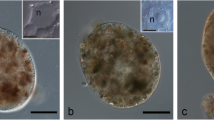Summary
A method for preparation of biological specimens for electron probe X-ray microanalysis is described, that aims at retaining the original elemental distribution within the tissue at the cellular level. The tissue is without any chemical fixation, quench-frozen, and 16-μm sections are prepared with a conventional cryomicrotome, transferred to a carbon specimen holder and freeze-dried.
Adjacent serial sections, collected on glass slides and stained with various histological procedures, are used to correlate the data obtained by X-ray microanalysis with other histochemical information on the same cell or tissue.
To demonstrate the possibilities of the method, sections of the earthworm Lumbricus terrestris were analyzed. In the chloragogenous cells, high concentrations of Ca, Zn and P were found. The inner and outer muscle layer show slightly different properties, both with regard to elemental composition and to myofibrillar ATPase activity.
Similar content being viewed by others
References
Brooke, M.H., Kaiser, K.K.: Muscle fiber types: How many and what kind? Arch. Neurol. 23, 369–379 (1970)
Gullvåg, B.M.: Metal measured in earthworm tissue by X-ray microanalysis. Proc. Ninth Int. Congress on Electr. Microsc., Toronto, Vol. II, pp. 114–115 (1978)
Ireland, M.P.: Distribution of lead, zinc and calcium in Dendrobaena rubida (Oligochaeta) living in soil contaminated by base metal mining in Wales. Comp. Biochem. Physiol. 52, 551–555 (1975a)
Ireland, M.P.: The effect of the earthworm Dendrobaena rubida on the solubility of lead, zinc and calcium in heavy metal contaminated soil in Wales. J. Soil. Sci. 26, 313–318 (1975b)
Ireland, M.P., Richards, K.S.: The occurrence and localization of heavy metals and glycogen in the earthworms Lumbricus rubellus and Dendrobaena rubida from a heavy metal site. Histochemistry 51, 153–166 (1977)
Padykula, H.A., Herman, E.: The specificity of the histochemical method for adenosine triphosphatase. J. Histochem. Cytochem. 3, 170–195 (1955)
Peters, P.D., Yarom, R., Dormann, A., Hall, T.: X-ray microanalysis of intracellular zinc: EMMA-4 examinations of normal and injured muscle and myocardium. J. Ultrastruct. Res. 57, 121–131 (1976)
Wróblewski, R., Roomans, G.M., Jansson, E., Edström, L.: Electron probe X-ray microanalysis of human muscle biopsies. Histochemistry 55, 281–292 (1978a)
Wróblewski, R., Gremski, W., Nordemar, R., Edström, L.: Electron probe X-ray microanalysis of human skeletal muscle involved in rheumatoid arthritis. Histochemistry 57, 1–8 (1978b)
Author information
Authors and Affiliations
Rights and permissions
About this article
Cite this article
Wróblewski, R., Roomans, G.M., Ruusa, J. et al. Elemental analysis of histochemically defined cells in the earthworm Lumbricus terrestris . Histochemistry 61, 167–176 (1979). https://doi.org/10.1007/BF00496529
Received:
Issue Date:
DOI: https://doi.org/10.1007/BF00496529




